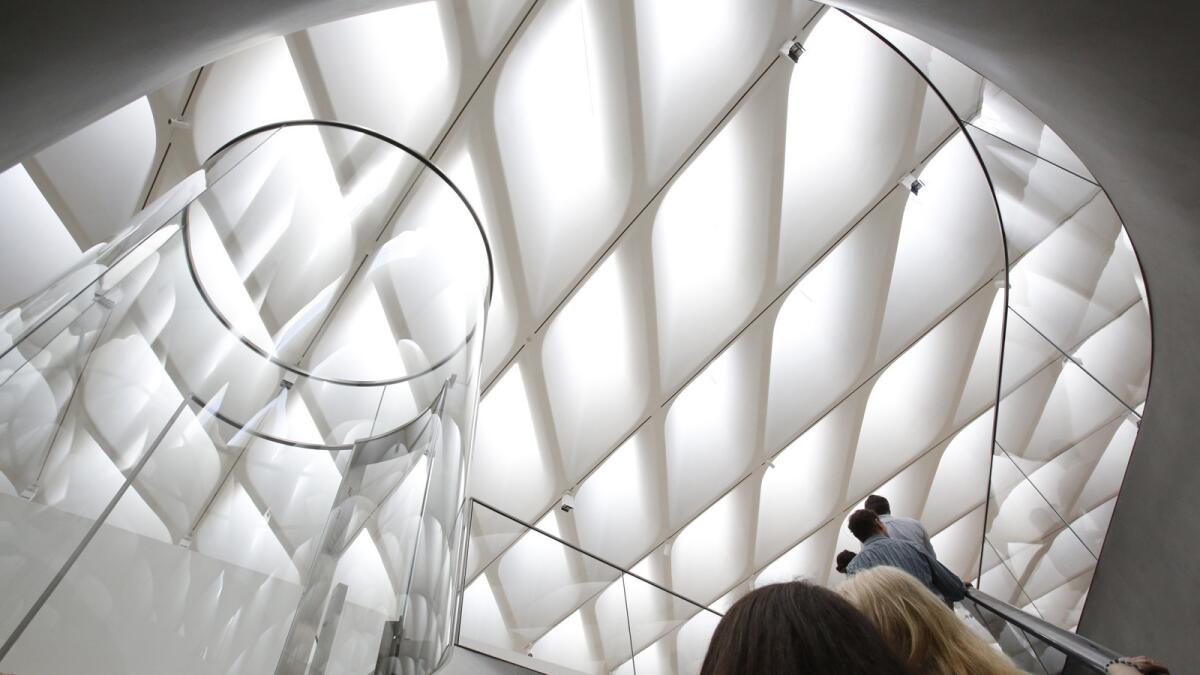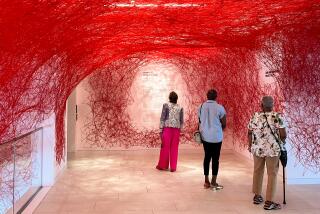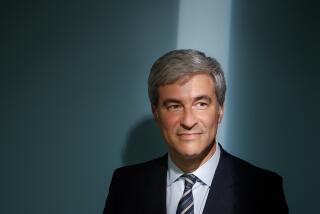The Broad doesn’t want museum guards between you and the art

A tour of the Broad museum as it prepares to open.
- Share via
Given the rare chance to create a new museum from scratch, the Broad is trying some innovative approaches. The one visitors might notice first is an absence of traditional museum guards who look and act as if their primary job is shooing away viewers who get too close to the art.
Visitors to the museum, which opens to the public Sunday, will see a friendlier, less institutional approach to security. The watchers in its galleries will be men and women who wear black clothes of their own choosing instead of uniforms — and who are trained to be affable, approachable founts of information about the art collection and anything else about the Broad and its environs that a visitor might want to know.
“We’re training all the floor staff in the museum to interact with you in a meaningful way about what’s on view,” museum director Joanne Heyler said. “We try to anticipate every question a visitor might ask, starting with, ‘How do you pronounce Broad?’ ” (Rhymes with “road.”)
SIGN UP for the free Essential Arts & Culture newsletter >>
The unusual approach to security won’t be the only departure from art museum norms. There won’t be a morsel to eat or a drop to drink on sale at the Broad, which thus avoided having to sacrifice gallery, lobby or art-storage space to make room for a kitchen or food concession.
There will be no central information desk in the lobby, a curvy and somewhat mysteriously cavernous gray space. The look will be the only mysterious thing about it, because museum staffers will be walking about in the lobby and on walkways outside as well as in the galleries, greeting each visitor and proffering answers about whatever mundane needs or concerns the public may bring inside.
There will be no fundraising appeals, and no signup sheet or website portal for enlisting volunteers. The Broad needs neither. Perhaps the most important aspect of the museum’s planning was the complete absence of financial pressure.
Funding is usually the biggest item on the agenda for new cultural institutions, or for established ones aiming to build new facilities. It just wasn’t a factor for museum founders Eli and Edythe Broad, multibillionaires who have been splurging for decades to build a 2,000-piece collection of contemporary art, and now have splurged some more to share it with the public, free of charge (although some future special exhibitions may carry a fee).
“I joke that the [fundraising] department is one person — me,” Heyler said. “And I have one prospect” — that being Eli Broad, her boss since 1989, when she began working on the collection as a curator.
The concept of merging the functions of a guard, an art guide and a concierge “emerged from looking where customer service is going” in the commercial retail sector, Heyler said. They’re being called Visitor Service Associates, or VSAs.
In choosing the 86 VSAs from among 500 applicants, the Broad looked for good learners with an affinity for people and good instincts for setting them at ease. Some of them are graduate students at art schools or art professors at community colleges; some called asking if they could volunteer at the Broad and were told they could not — but they could apply for a paid job.
The Broad also will be unusual in things it deliberately omits.
The VSAs will wear their own clothes rather than museum-issue garb — the thinking being that self-expression, within certain professional parameters for garment lengths and contours, should be valued in an art museum. Red lanyards with name tags will separate the staff from everyone else who shows up in basic black.
Eli Broad had decided his collection would become a museum in roughly 2008, but the Broads and Heyler were by no means starting the planning from scratch. Since 1984, the collection has acted as a lending library circulating art to other museums. That has meant handling many of the logistical intricacies at the heart of museum work — packing and transporting art, hanging it to achieve the most striking effects and juxtapositions, and keeping tight security over works that in some cases might today be worth $100 million or more.
When the time came to seek advice about how to turn a collection into a museum, the founders and their director could laser in on the specific, detailed areas where they’d need expert help.
They took some important cues from museum professionals, but also from Steve Jobs and from trucking companies that vetted plans for the loading dock.
Mulling how to move visitors smoothly into the galleries, Heyler thought of Apple stores, where there’s no crush at the cash register because there’s no cash register. Ticketing — free, timed reservations — will be handled by VSAs toting hand-held devices that assign the times and dispense the tickets. (There will be a couple of cash registers at the museum store.)
The Broad won’t admit more than 400 visitors an hour — for a maximum of 4,000 a day, which would be astronomical for a museum of contemporary art.
“It isn’t much fun to be in an overcrowded gallery,” Heyler said. “We’re going to watch very carefully to strike the right balance and keep artworks safe from accidental bumping that can happen when there’s overcrowding.”
Two of the nearest food and drink options for Broad visitors will be coffee and snack carts on plazas on either side of Grand Avenue — one operated on the Broad side by Otium, a new restaurant that’s being finished at the back of the plaza, and the other posted outside the Museum of Contemporary Art, along with chairs and umbrella tables, by the Lemonade restaurant chain, MOCA’s food concessionaire.
But it’s the VSAs that may particularly grab museum professionals’ attention. The Chrysler Museum of Art in Norfolk, Va., may be the only other art museum that has attempted to train staffers to fully fulfill the seemingly contradictory functions of keeping the art safe while making viewers feel comfortably at home with it.
“This is leading-edge, and it’s a very positive thing for the Broad,” said Kathleen Brown, principal consultant for Lord Cultural Resources, a Toronto-based firm that helps plan major projects such as the Art Institute of Chicago’s modern art wing, and the Smithsonian National Museum of African American History and Culture.
“One of the great deterrents to museum visitation is that many people are intimidated by a museum’s demeanor,” Brown said. “If you have a guard standing at every entrance to a gallery and trained in a way that isn’t necessarily overtly friendly, it’s not conducive to interacting and responding to the art.”
Colleen Higginbotham, director of visitor services at the Chrysler museum, says it gauges the success of the “gallery hosts” it has deployed since 2007 by answers to a standard survey question about whether visitors would recommend the Norfolk museum to a friend. She said that 94% say yes.
“Many times people are anxious when they come to a museum, because they don’t think they know enough,” Higginbotham said. “We try to make them feel they belong, and there’s no such thing as a stupid question.”
But Stevan Layne, a veteran security consultant to museums and other cultural sites, is not persuaded that pleasant conversation and detailed knowledge about art should be in gallery attendants’ job descriptions. To him, it’s a way for museums to cut costs by folding separate security and visitor service functions into one. “I’m opposed to doing that,” Layne said. “It can be a distraction from the primary mission” of protecting the art.
At the Broad, the VSAs will be the most prominent eyes and ears — and mouths — but they’ll be augmented by smaller staffs of security managers who’ll be clad in suits and ties, and by contracted guards in police-like blue uniforms, whose duties will include manning a garage-level security station where monitors take feeds from dozens of cameras inside and outside the museum.
Rich Cherry, the Broad’s deputy director, said it’s understandable that traditional approaches will die hard in museums, but he’s confident that steady interaction with visitors improves rather than distracts from security because it sends a message that museum staff are present and on the alert — albeit in a very friendly way.
“It’s harder to change a system that has all the pieces in place,” Cherry said. The Broad decided to take a rare opportunity to build a system of its own.
MORE:
Eli Broad calls his collection ‘unique in the world,’ says building ‘exceeded’ expectations
Ed Ruscha, meet Val Kilmer: Art world, Hollywood to collide at Broad museum parties
An early look in the Broad museum reveals a show that doesn’t quite gel
More to Read
The biggest entertainment stories
Get our big stories about Hollywood, film, television, music, arts, culture and more right in your inbox as soon as they publish.
You may occasionally receive promotional content from the Los Angeles Times.











